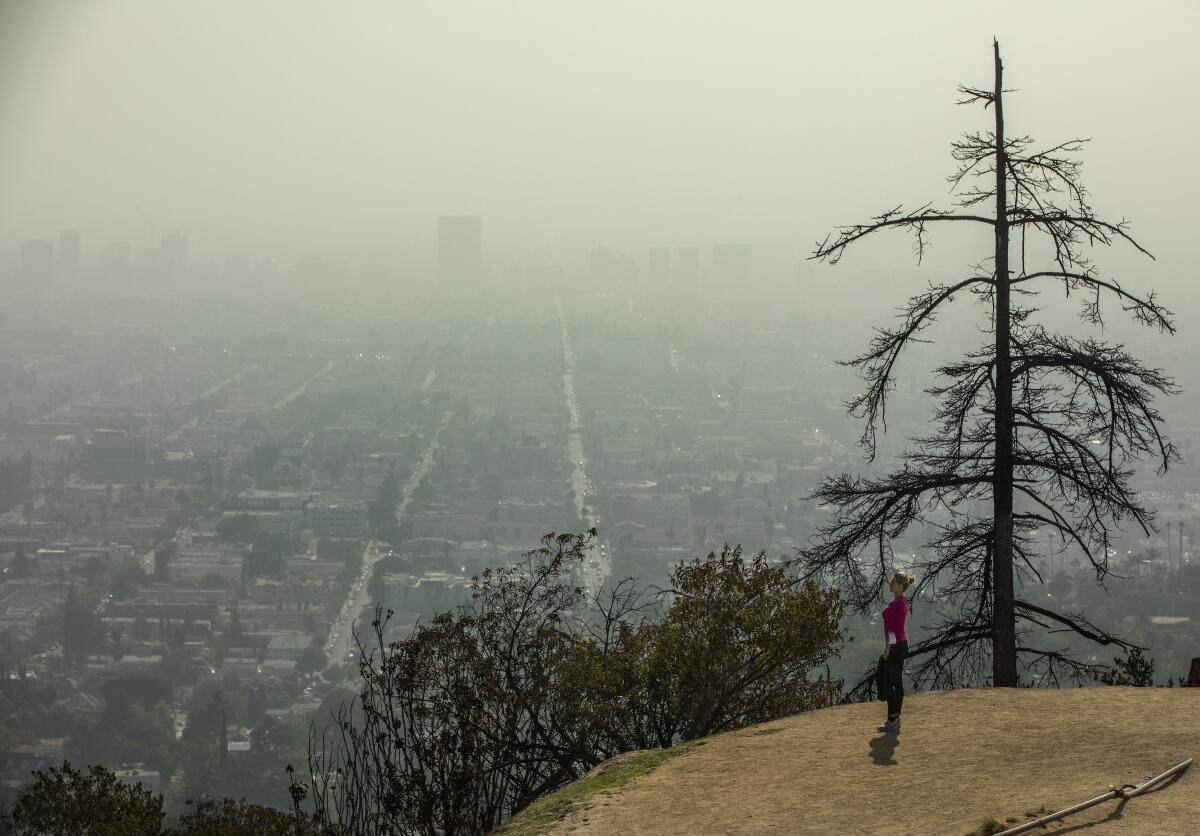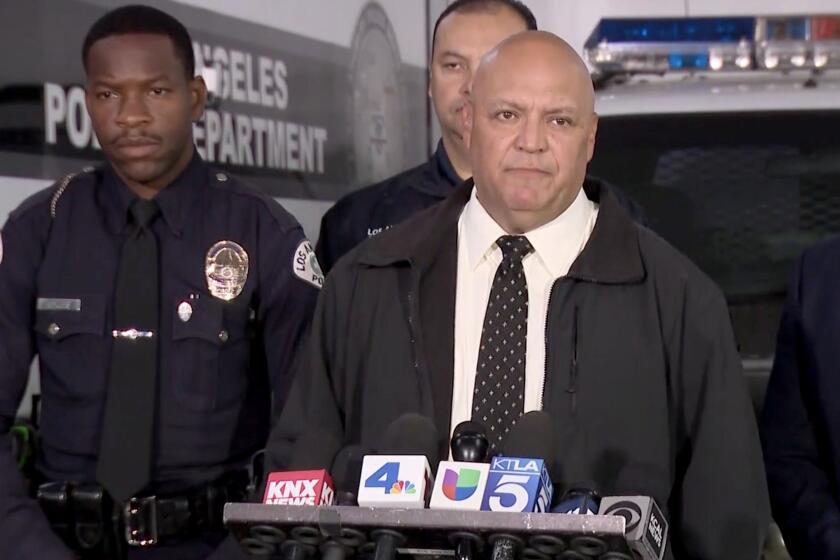That brown, hazy air is bad for your kids

This is the Dec. 13, 2021, edition of the 8 to 3 newsletter about school, kids and parenting. Like what you’re reading? Sign up to get it in your inbox every Monday.
I hate smog. I really hate smog. I spend much of the summer months in Los Angeles obsessively monitoring air quality apps and just waiting for November to arrive. By then, if there are no wildfires, I can go hiking without using my inhaler. I can see the meandering furrows that mark the San Gabriel Mountains from my bedroom window.
This year, though, a brown haze has replaced the blue skies of late fall, despite a mild fire season in Southern California. As someone with asthma, there have been many days where I’ve had to weigh whether going on a run — a practice that helps me maintain my emotional and mental health — is worth the risk when I know it might trigger an attack. It made me think about the childhood equivalent: recess, playing sports, skateboarding, riding bikes — all activities that are so important to kids’ well-being, especially after a year of being stuck inside.
Prolonged exposure to air pollution is bad for everyone but especially children, whose growing lungs and immature immune systems are more sensitive to pollutants, experts say. They also tend to spend more time outside and breathe more rapidly than adults.
I spoke with several air quality and pediatric lung health experts about how parents can reduce their kids’ exposure to air pollution year-round.
So what’s going on with the air?
Ozone pollution accounts for most of the smog we see in summer. And although cooler months often give us a respite from dirty air, winter is also more hospitable to particulate-matter pollution.
Particles known as PM 2.5, which are tiny enough to penetrate deeply into the lung and cross over into the bloodstream, are especially troublesome. These particles can cause inflammation and impair the body’s ability to fight infection. They can irritate the eyes, nose and throat. They can also trigger strokes, asthma attacks and heart attacks, and are a cause of premature death worldwide.
In November, the South Coast Basin — which includes Orange, Los Angeles, Riverside and San Bernardino counties — recorded nine days in which the daily average of PM 2.5 exceeded the national 24-hour health standard, according to air quality data. The entire first week of December was in that unhealthy range before the rain arrived.
“We’ve experienced more days of high fine particulate matter than normal this winter,” Kim White, a spokeswoman for the Air Quality Management District, told The Times.
Over the last few years, similar periods of unhealthful air in SoCal were the result of massive heat waves and wildfires burning across the region. But Southern California has so far been spared the devastating fires of recent years.
“For the past three years, we’ve seen relatively clean air data, aside from wildfires,” Adrian Martinez, senior attorney at environmental nonprofit Earthjustice, told me. “What’s uncomfortable about this season’s pollution is that we can’t point to any one source.”
Meteorologists say that a strong marine layer, also known as an inversion, is partially responsible for the bad air. But the ships, trains and airplanes that move freight in and out of the region — as companies like Amazon scramble to meet soaring consumer demand — are also likely contributors, said Edward Avol, a professor of environmental health and preventive medicine at USC.
My colleague Nathan Solis reported that anchored-ship emissions in the twin ports of Long Beach and L.A. jumped from just 1% of overall ship emissions to 42% of emissions in December 2020.
What’s this doing to kids?
Though every child varies in terms of their sensitivity, health status and genetics, those who are repeatedly and heavily exposed to air pollution are more likely to develop asthma and other adverse health effects.
“Generally speaking, the more PM 2.5 you’re exposed to, the shorter your lifespan and quality of life. It alters your immune system,” said Mary Prunicki, an air pollution expert at Stanford University’s Center for Allergy and Asthma Research. “We know especially that when PM 2.5 is coming from a wildfire, exposure will result in increases in ER visits and hospitalizations for asthma exacerbations among kids, as well as pneumonia and acute bronchitis.”
Kids who live near freeways, refineries and power plants, who are disproportionately Black and Latinx, are particularly vulnerable. People of color are exposed to more pollution from just about every kind of source, including industry, agriculture, vehicles and construction. Exposure to higher smog levels has been linked to greater risk of dying from COVID-19. Studies have even shown a connection between air quality and childhood academic performance.
How can we protect children?
Kids don’t adjust their behavior if it’s a smoggy day outside,so we have to make those informed choices for them.
If you don’t already, you should start monitoring the Air Quality Index (AQI) in your area. The experts I interviewed recommended the EPA’s AirNow app and PurpleAir, which hosts a map of real-time air quality measurements from 20,000-plus sensors people have installed at home.
Parents should consider limiting their child’s rigorous outdoor exercise if the AQI is above 100 (the orange zone), and perhaps discourage it entirely once it’s in the “unhealthy” range (red). If a kid has asthma, though, you may want to do this even if the AQI is between 50 and 100 (yellow).
“Even if the guidelines say it’s fine,” Prunicki advised, “if your child is coughing or having any breathing problems, certainly ignore that and follow what you feel is good for your child.”
And if you can, keep your kids from running around near busy roadways, said Sylvia Betancourt, program manager for the Long Beach Alliance for Children With Asthma. This holds especially true for asthmatic kids.
When air isn’t downright hazardous, you could encourage your kids to play outside in the morning (or after sunset, for older kids) when air quality tends to be better, said Sally Davidson Ward, chief of the Division of Pulmonology and Sleep Medicine at Children’s Hospital Los Angeles.
“Because of the pandemic, we now know that keeping otherwise healthy children indoors has its own risks,” Ward said. “It’s difficult when we live in Southern California, where so many days are impacted by air pollution.”
N95 masks filter out most particulate matter but don’t work very well without a tight seal, Prunicki said — so they’re not a realistic option for kiddos.
Indoor air quality is also so important. If you’re leaving your windows open or cracked on high-AQI days, or your house is old and drafty, the air in your home may be as bad as the air outside. Invest in an air purifier — or a few! — if you can.
The youth mental health crisis (and other news)
U.S. Surgeon General Vivek H. Murthy issued a public health advisory on the mental health challenges confronting kids and teens, a rare warning and call to action to address an emerging crisis made worse by pandemic hardships. Symptoms of depression and anxiety have doubled during the pandemic — with a staggering 25% of youth experiencing depressive symptoms and 20% experiencing anxiety symptoms, according to Murthy’s advisory. Negative emotions or behaviors such as impulsivity and irritability have also become more common among kids, reports my colleague Howard Blume.
K-12 educators are reporting a rise in school threats, fights and misbehavior — and they’re blaming COVID-19. Times education reporter Melissa Gomez spoke with teachers and school administrators who said students had increasingly been acting out in class and behaving aggressively. For example, after the Nov. 30 Michigan school shooting, in which a 15-year-old student has been charged with murder, more than a dozen school districts in California canceled classes, citing potential threats posted online. “Young people don’t know how to cope when they’re depressed and angry,” said Tyrone Howard, education professor at UCLA.
L.A. Unified School District has named a new superintendent. Alberto Carvalho, who has led Miami-Dade County Public Schools since 2008 and is among the nation’s most experienced and admired school district leaders, is set to take on one of the highest-profile and most challenging posts in public education. Carvalho, 57, will jump into a school system in which many students have long struggled to achieve and were further set back — academically and emotionally — by the pandemic.
Enjoying this newsletter?
Consider forwarding it to a friend, and support our journalism by becoming a subscriber.
Did you get this newsletter forwarded to you? Sign up here to get it in your inbox every week.
What else we’re reading
A substitute teacher shortage in the Bay Area is hurting students, who are walking out of classrooms and wandering the halls once they realize no one is going to show up to teach them. KQED
How can schools detect potentially violent students? Many academics and school officials say that the difficult decision of whether to remove students who are exhibiting disturbing behaviors should be made by a multidisciplinary team including administrators, school-based police officers and mental health professionals. The Washington Post
School districts across the nation are opting to close on Fridays — at least temporarily — as they grapple with a rise in coronavirus cases and burned-out teachers. Some public schools are going remote on Fridays, while others are canceling classes entirely. The New York Times
I want to hear from you.
Have feedback? Ideas? Questions? Story tips? Email me. And keep in touch on Twitter.
Start your day right
Sign up for Essential California for news, features and recommendations from the L.A. Times and beyond in your inbox six days a week.
You may occasionally receive promotional content from the Los Angeles Times.




